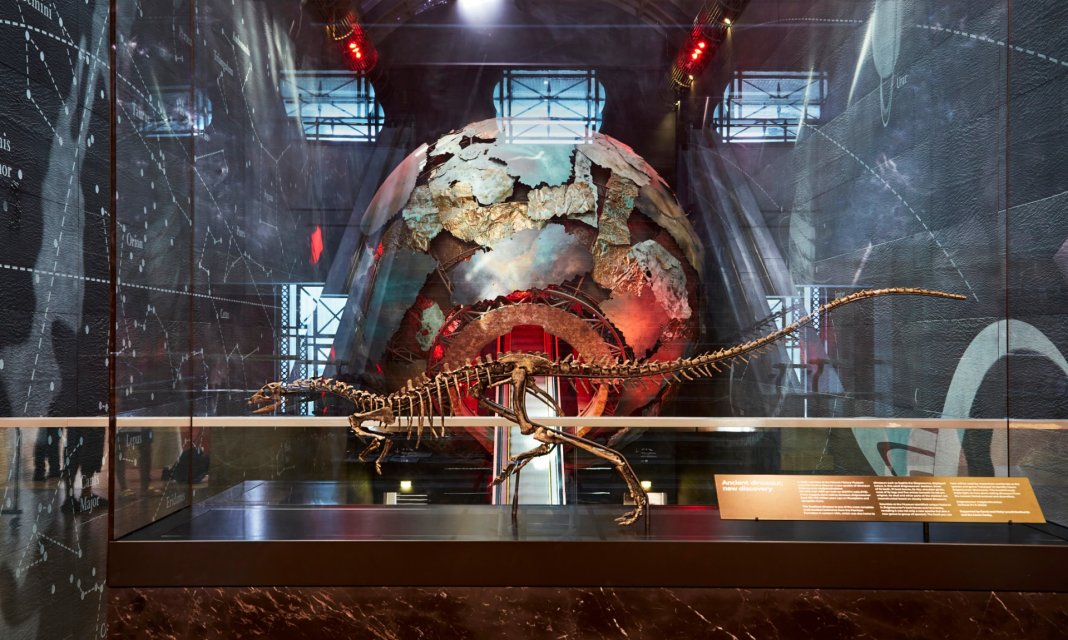Scientists solve 150-year taxonomic puzzle with discovery of speedy herbivore from American West
A previously unknown species of dinosaur has made its public debut at London’s Natural History Museum, marking the end of a century-long scientific mystery and adding a new chapter to our understanding of prehistoric life.
Enigmacursor mollyborthwickae, a small, two-legged herbivore that roamed the floodplains of western North America 145-150 million years ago, went on permanent display Thursday in the museum’s Earth Hall. The diminutive dinosaur, standing just half a meter tall and measuring slightly over a meter in length, represents a significant breakthrough in paleontological research.
The discovery resolves a taxonomic tangle that has puzzled scientists since the 1870s. When the fossil was first acquired in 2021-2022 from a commercial quarry, researchers initially believed it belonged to Nanosaurus, a poorly understood species first identified nearly 150 years ago.
However, detailed analysis by Natural History Museum paleontologists Professor Susannah Maidment and Professor Paul Barrett revealed the specimen was something entirely new to science. Their research, published in the journal Royal Society Open Science, officially retired the problematic Nanosaurus classification and established Enigmacursor mollyborthwickae as a distinct species.
“The generous donation of this rare specimen has had quite unexpected scientific repercussions,” said Professor Maidment, co-lead author of the study. “By studying its anatomy in detail, we’ve been able to clarify this species’ evolutionary relationships, its taxonomy and the diversity of a previously poorly understood group of small dinosaurs.”
Enigmacursor mollyborthwickae lived during the Late Jurassic period in what is now the western United States, sharing its environment with some of the most famous dinosaurs in history. While giants like Diplodocus and Stegosaurus dominated the landscape—both species also housed at the Natural History Museum—this small herbivore carved out its own ecological niche.
The dinosaur’s name reflects both its mysterious past and its probable lifestyle. “Enigma” references the taxonomic confusion surrounding similar fossils, while “cursor” suggests it was built for speed—a crucial adaptation for a small plant-eater living among massive predators and competitors.
Evidence suggests the museum’s specimen was not fully mature when it died. The neural arches of its vertebrae had not completely fused with the lower portions of the spine, indicating the dinosaur was likely quite young when fossilized.
The discovery highlights the critical importance of rigorous taxonomic work in paleontology. Professor Maidment emphasized that proper classification underpins all paleontological research.
“Getting taxonomy right is vital; it underpins everything we do as palaeontologists and if we get it wrong, everything else collapses,” she explained. “Rather than simply assigning fossils to familiar names, this discovery shows just how vital rigorous taxonomic work is—which requires us to get in front of and scrutinise new fossils—to inform our understanding of the evolution of these fascinating creatures.”
The research team’s decision to set aside the Nanosaurus name, despite its historical significance, demonstrates the scientific community’s commitment to accuracy over tradition when evidence demands revision.
The specimen’s journey to the Natural History Museum began in a commercial quarry in the Morrison Formation, a geological treasure trove that has yielded numerous dinosaur discoveries over the past century and a half. The museum acquired the fossil from gallery David Aaron Ltd, thanks to the generous support of David and Molly Lowell Borthwick, after whom the species is named.
Professor Paul Barrett, co-lead author of the research, noted the significance of making such discoveries accessible to the public. “Unveiling Enigmacursor mollyborthwickae in our world-class natural history museum, whilst also placing it reliably onto the evolutionary tree, is an incredibly exciting milestone,” he said.
The establishment of Enigmacursor mollyborthwickae as a new species opens new avenues for research. Scientists now face the question of whether other specimens around the world previously classified as Nanosaurus might also represent distinct species that shared the Morrison Formation landscape millions of years ago.
This ongoing research could potentially reveal an entire ecosystem of small herbivorous dinosaurs that have been overlooked or misclassified, painting a more complete picture of Late Jurassic biodiversity in North America.
The Natural History Museum, already home to some of the world’s most famous dinosaur specimens including Dippy the Diplodocus and Sophie the Stegosaurus, now adds another significant specimen to its collection. The display of Enigmacursor mollyborthwickae on the first-floor mezzanine in Earth Hall represents part of the museum’s broader commitment to showcasing natural world treasures.
The exhibition comes as the museum prepares for extensive gallery redevelopments ahead of its 150th anniversary, with plans to create new advocates for planetary conservation through improved displays and public engagement.
Enigmacursor mollyborthwickae is now on permanent public display at the Natural History Museum, located on the first-floor mezzanine in Earth Hall. Visitors are encouraged to book free tickets in advance online to guarantee entry, though members, patrons, and corporate supporters can arrive at any time with priority access.
The addition of this newly discovered species to the museum’s world-renowned dinosaur collection offers visitors a unique opportunity to encounter a creature that has literally just been introduced to science, bridging the gap between cutting-edge research and public education.
As paleontologists continue to uncover and properly classify fossils from around the world, discoveries like Enigmacursor mollyborthwickae remind us that there are still countless secrets waiting to be revealed in Earth’s ancient rock formations—and that sometimes, solving old mysteries can be just as exciting as making entirely new discoveries.
A Little Bit of London In Your Inbox Weekly. Sign-up for our free weekly London newsletter. Sent every Friday with the latest news from London!



